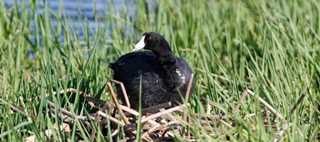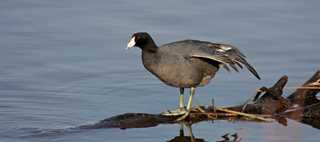In Defense of the Coot
The much-maligned 'mud hen' doesn't get the respect it deserves
The much-maligned 'mud hen' doesn't get the respect it deserves
By Gary Koehler
The American coot, unquestionably the Rodney Dangerfield of the waterfowling world, is not only lacking in respect, but has often been called somewhat unflattering names, such as mud hen. Folks are considerably more kind in Louisiana's marsh country, where poule d'eau translates to "water hen."
The coot is an afterthought among most duck and goose hunters, but perhaps it's time the bird received proper recognition.
Members of the rail family, coots rarely weigh more than a pound and a half. They have small chicken-like bills, long legs, and lobed scales on their toes. Coots must run atop the water in order to gain flight. They are found seasonally across much of the United States and as far south as Panama, commonly rafting in vast flocks on wide-open freshwater lakes and reservoirs. Migrating mostly at night, coots often arrive unexpectedly. The majority of gunners barely take notice. The exceptions may be at specific sites, such as Georgia's Lake Seminole, where congregations of 250,000 coots are not uncommon. There, coot decoys are hunter staples.

Photo © Michael Furtman
There are those who have long recognized value in this diminutive bird. The late Eli Haydel, a duck call-making icon from southern Louisiana, loved telling the story of a Cajun octogenarian who relied on faux coots every time he hunted the marsh. "There was this old-timer I knew," Eli told me one slow morning in his blind, "and he'd put out a small rig of coot decoys, maybe a dozen, and one pintail decoy. He'd shoot his pintails every day. I guess those pintails felt safe when coots were around."
Employing coots as confidence decoys-or to attract live coots-can be traced to many of the earliest commercial decoy makers. The J.M. Hays Wood Products Company, for instance, advertised coot decoys as early as 1921. Mason, Peterson, Herters, Pratt, Evans, Gundelfinger, Victor, and others also marketed the small black birds to waterfowl hunters. At least four contemporary decoy makers include plastic coots in their respective product lines today.
Any number of historically recognized decoy makers, including California luminaries such as Luigi Andreuccetti, Ed Snyder, and Pappy Kidwell to East Coast craftsmen like Madison Mitchell and Ned Burgess carved coots. Louisiana carvers are high on the productivity list, with Mark Whipple, Mitchell LaFrance, and Xavier Bourg heading the coot-making roster. But perhaps the all-time busiest coot carvers in one area resided in Wisconsin's Lake Winnebago region. This list includes state heavyweights such as Gus Moak, Frank Resop, and Frank Strey, among many others.

Photo © Michael Furtman
Whether or not coots are fit for the table has long been a subject of debate among waterfowlers. Louisianans have included coots in their traditional gumbos for generations. And I have eaten coot stew that was surprisingly tasty. For a simpler means of preparation, try the following recipe. Breast out the bird and remove all the fat and silver membrane. Place the meat in a skillet with oil, onions, mushrooms, and garlic, and sauté the ingredients, seasoning with salt and pepper to taste. This is not necessarily an endorsement, but rather basic instruction. Bon appétit.
PLAY BALL Cheers are in order for the International League baseball franchise in Toledo, Ohio. The team was dubbed the "Mud Hens" in 1896 while playing at Bay View Park and has retained that name nearly every year since. The old park was surrounded by marsh, which attracted hordes of American coots.
Everything else you need to know about coots can be found at DU Waterfowl ID.
Ducks Unlimited uses cookies to enhance your browsing experience, optimize site functionality, analyze traffic, and deliver personalized advertising through third parties. By continuing to use this site, you agree to our use of cookies. View Privacy Policy